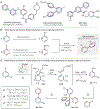Heterobiaryl synthesis by contractive C-C coupling via P(V) intermediates
- PMID: 30442804
- PMCID: PMC6814017
- DOI: 10.1126/science.aas8961
Heterobiaryl synthesis by contractive C-C coupling via P(V) intermediates
Abstract
Heterobiaryls composed of pyridine and diazine rings are key components of pharmaceuticals and are often central to pharmacological function. We present an alternative approach to metal-catalyzed cross-coupling to make heterobiaryls using contractive phosphorus C-C couplings, also termed phosphorus ligand coupling reactions. The process starts by regioselective phosphorus substitution of the C-H bonds para to nitrogen in two successive heterocycles; ligand coupling is then triggered via acidic alcohol solutions to form the heterobiaryl bond. Mechanistic studies imply that ligand coupling is an asynchronous process involving migration of one heterocycle to the ipso position of the other around a central pentacoordinate P(V) atom. The strategy can be applied to complex drug-like molecules containing multiple reactive sites and polar functional groups, and also enables convergent coupling of drug fragments and late-stage heteroarylation of pharmaceuticals.
Copyright © 2018 The Authors, some rights reserved; exclusive licensee American Association for the Advancement of Science. No claim to original U.S. Government Works.
Conflict of interest statement
Figures




Similar articles
-
Phosphorus-mediated sp2-sp3 couplings for C-H fluoroalkylation of azines.Nature. 2021 Jun;594(7862):217-222. doi: 10.1038/s41586-021-03567-3. Epub 2021 Apr 28. Nature. 2021. PMID: 33910228
-
Palladium-catalyzed carbon-sulfur or carbon-phosphorus bond metathesis by reversible arylation.Science. 2017 Jun 9;356(6342):1059-1063. doi: 10.1126/science.aam9041. Science. 2017. PMID: 28596362
-
Nonsymmetrical Bis-Azine Biaryls from Chloroazines: A Strategy Using Phosphorus Ligand-Coupling.J Am Chem Soc. 2019 Sep 25;141(38):15441-15449. doi: 10.1021/jacs.9b08504. Epub 2019 Sep 16. J Am Chem Soc. 2019. PMID: 31483634 Free PMC article.
-
Synthesis of Nitrogen Heterocycles Using Samarium(II) Iodide.Molecules. 2017 Nov 21;22(11):2018. doi: 10.3390/molecules22112018. Molecules. 2017. PMID: 29160806 Free PMC article. Review.
-
Iron-Catalyzed Cross-Couplings in the Synthesis of Pharmaceuticals: In Pursuit of Sustainability.Angew Chem Int Ed Engl. 2018 Aug 27;57(35):11116-11128. doi: 10.1002/anie.201800364. Epub 2018 Jul 17. Angew Chem Int Ed Engl. 2018. PMID: 29460380 Review.
Cited by
-
First total synthesis of caerulomycin K: a case study on selective, multiple C-H functionalizations of pyridines.RSC Adv. 2024 Feb 13;14(8):5542-5546. doi: 10.1039/d4ra00589a. eCollection 2024 Feb 7. RSC Adv. 2024. PMID: 38352680 Free PMC article.
-
Transition-Metal-Free Oxidative Cross-Coupling of Tetraarylborates to Biaryls Using Organic Oxidants.Angew Chem Int Ed Engl. 2020 Sep 1;59(36):15468-15473. doi: 10.1002/anie.202002595. Epub 2020 Apr 24. Angew Chem Int Ed Engl. 2020. PMID: 32159264 Free PMC article.
-
A General, Multimetallic Cross-Ullmann Biheteroaryl Synthesis from Heteroaryl Halides and Heteroaryl Triflates.J Am Chem Soc. 2021 Dec 29;143(51):21484-21491. doi: 10.1021/jacs.1c10907. Epub 2021 Dec 17. J Am Chem Soc. 2021. PMID: 34918908 Free PMC article.
-
The 2-Pyridyl Problem: Challenging Nucleophiles in Cross-Coupling Arylations.Angew Chem Int Ed Engl. 2021 May 10;60(20):11068-11091. doi: 10.1002/anie.202010631. Epub 2020 Nov 17. Angew Chem Int Ed Engl. 2021. PMID: 32940402 Free PMC article. Review.
-
Direct carbonyl reductive functionalizations by diphenylphosphine oxide.Sci Adv. 2025 Feb 7;11(6):eads4626. doi: 10.1126/sciadv.ads4626. Epub 2025 Feb 7. Sci Adv. 2025. PMID: 39919176 Free PMC article.
References
-
- Brown DG, Boström J, J. Med. Chem 59, 4443–4458 (2016). - PubMed
-
- Roughley SD, Jordan AM, J. Med. Chem 54, 3451–3479 (2011). - PubMed
-
- Capdeville R, Buchdunger E, Zimmermann J, Matter A, Nat. Rev. Drug Discov 1, 493–502 (2002). - PubMed
-
- Roecker AJ et al., ChemMedChem 9, 311–322 (2014). - PubMed
-
- Martina SD, Vesta KS, Ripley TL, Ann. Pharmacother 39, 854–862 (2005). - PubMed
Publication types
MeSH terms
Substances
Grants and funding
LinkOut - more resources
Full Text Sources
Other Literature Sources
Medical

